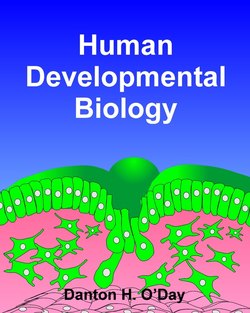Читать книгу Human Developmental Biology - Danton Inc. O'Day - Страница 9
How Do the PGCs Know Where to Go?
ОглавлениеJust how do the PGCs find their way to the genital ridges? How do they keep from getting lost in this long and arduous journey? There is evidence that the genital ridges secrete some chemoattractant that guides the PGCs towards them. PGCs migrate by extending filopodia (very fine pseudopods) and the cells migrate between the cells in various tissues. In addition, PGCs follow extracellular matrix components that serve as "roadways" leading to the genital ridges. These roadways are lined with fibronectin. There is evidence that the integrins are involved in the migration of PGCs since mutants lacking integrins fail to migrate into the gonads. Integrins are localized to the surface of cells where they act as receptors for molecules (e.g., fibronectin) in the ECM.
Figure 2.3 presents is a theoretical demonstration of how PGCs (red) might use their surface integrins to follow an embryonic "roadway" of extracellular material to reach the genital ridges. The yellow is meant to reflect a theoretical complex of ECM components (e.g., laminin, fibronectin, collagen) rather than a single entity such as fibronectin. Cells would stay within the yellow ECM region rather than wander into adjacent regions because they would have preferential adhesiveness ("stickiness") to the yellow "roadway". The lower image in Figure 2.3 shows a primordial germ cell moving along the ECM via binding of the cell adhesion molecule integrin to fibronectin in the ECM.
Figure 2.3. The migration of PGCs. Embryonic localization as revealed by staining for alkaline phosphatase (Top image). The role of integrin and fibronectin binding in PGC migration (Bottom image).
PGC migration is also controlled by signal transduction involving TGF-beta 1 (TGFβ1) that is secreted by the genital ridge. TGFβ1, which is discussed in subsequent chapters, acts as a chemoattractant but inhibits proliferation thereby modulating the number of primary germ cells in the gonad. The topics of chemotaxis and extracellular "roadways" will be discussed in more detail in future chapters especially when we detail the migration of neural crest cells in Chapter 12.
